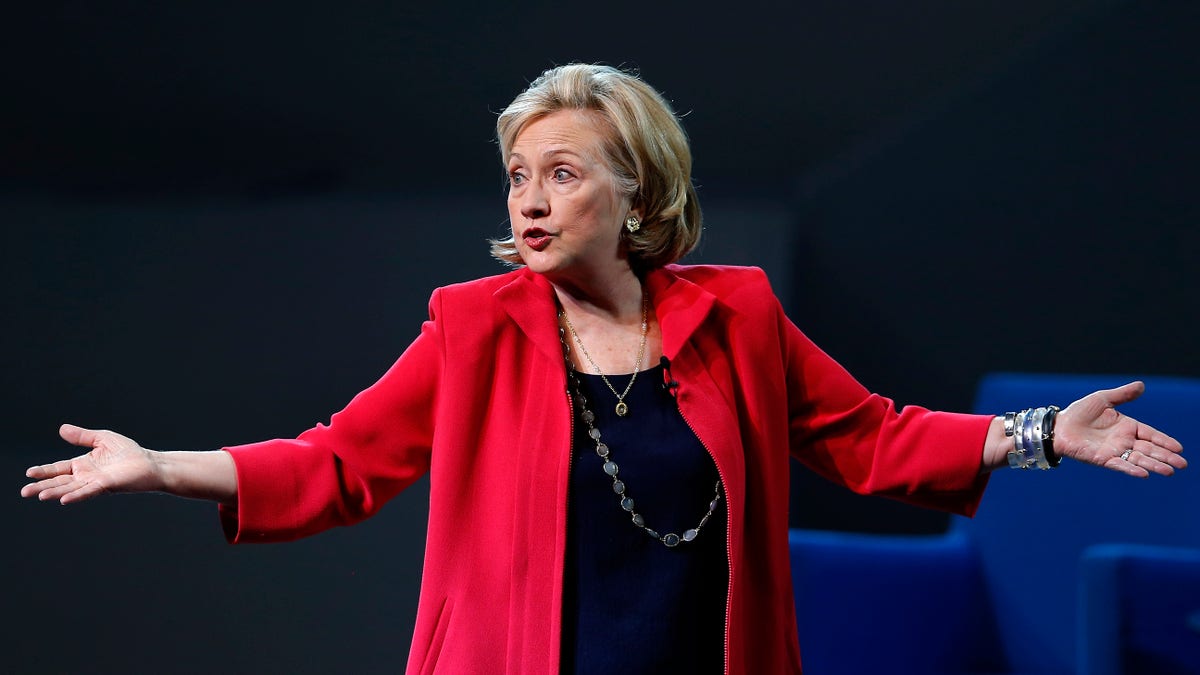
Sept. 5, 2014: Former Secretary of State Hillary Clinton speaks to the scholarship recipients of the Telmex Foundation during the annual Mexico XXI Century event. (AP)
Hillary Clinton. Angela Merkel of Germany. And now Theresa May of Britain. Women rule, or soon may, three of the world’s most influential democracies.
They are not alone. Christine Lagarde, of France, heads the powerful International Monetary Fund, responsible for assuring the stability of the international financial system. In Scotland, Nicola Sturgeon, Scotland’s first minister, is a rising star. The first minister of Northern Ireland is a woman. So is the leader, and former leader, of Britain’s Green party. The next United Nations Secretary General might also be a woman.
After the vote among conservative Tories, British Home Secretary Theresa May now seems likely to become Britain’s next prime minister. Her rival in the conservative leadership race is Andrea Leadsom, the energy minister and a former banker. Angela Eagle, a Labor member of Parliament, has announced that she may try to challenge her party’s incompetent leader, Jeremy Corbyn.
Writing for the German daily Die Welt, Mara Delius, a woman, asserted that Merkel, May, Sturgeon, and other women politicians represent a new “femokratie” now being asked to “clean up the mess created by the men.” Thanks to these “postmodern Elektras in trouser suits and rubber gloves,” she writes, Europe, and the world, at last, may be in capable (female) hands.
Desperate times may demand such desperate measures. Within the past year, Taiwan, Nepal, Croatia, Mauritius and Lithuania have all elected, or re-elected female leaders to office. Last November, Nobel peace prize winner Aung San Suu Kyi’s party won a landslide victory in Myanmar’s first democratic elections after 25 years of military rule.
America, too, may well be doubling down on the great feminist hope. The U.S. Attorney General is a woman. And if some Democratic party activists have their way, Mrs. Clinton could select Democratic Senator Elizabeth Warren, of Massachusetts, as her running mate. That’s not likely. But the prospect of an all-female Democratic ticket underscores the fact that women, finally, belatedly, are getting some respect in electoral politics.
The U.S. has lagged woefully behind Europe and even developing countries in granting women the right to rule. Margaret Thatcher, Britain’s “Iron Lady,” led Britain from 1979 to 1990, the longest-serving British prime minister of the 20th century. The election of Cory Aquino as president of the Philippines in the mid-1980’s was widely regarded as the islands’ first step towards democracy. Golda Meir, Israel’s fourth prime minister, guided her country through peace and war from 1969 to 1974. Benazir Bhutto, of Pakistan, hardly a bastion of enlightenment when it comes to female rights, became her country’s first female prime minister in 1988, and might have won again had she not been killed by a suicide bomber in 2007. Indira Gandhi served as India’s third prime minister from 1966 to 1984, when she, too, was assassinated. Even tiny Iceland, population 330,000, has a female prime minister, Jóhanna Sigurðardóttir.
America’s resistance to females at the top is not confined to politics. In business, Facebook’s chief operating officer Sheryl Sandberg complained that women hold only 15-16 percent of top business jobs and board seats. “The numbers have not moved since 2002 and are going in the wrong direction,” she said in a much watched TED talk. Even in the non-profit world, where worker bees are overwhelmingly female, men hold some 80 percent of the top jobs.
Of course, female power may not be the answer to slow economic growth, growing income inequality, deep political fractiousness and the soaring alienation of so many Americans and other citizens from their governments. In South America, Brazil’s President Dilma Rousseff was suspended from office last May amid charges of corruption and incompetence. In Argentina, Cristina Fernández de Kirchner, the former president, faces a fraud inquiry.
But Americans of both parties seem increasingly willing, or desperate enough to give women a chance. And why not? Could they possibly make more of a mess than the current crop of male leaders have made? In Britain, would Theresa May, a no nonsense engineer who supported continued membership in the European Union with little enthusiasm, have risked her country’s economic future as conservative leader David Cameron did by insisting on a referendum on continued EU membership? Would she have stomped away from politics like a spoiled child as her conservative colleague Boris Johnson did after successfully leading the campaign for “Brexit”? Would she whine about “wanting her life back” as Nigel Farage did in explaining why he, too, was deserting his UKIP party and politics at this dangerous moment of transition for Britain? Not bloody likely, as Margaret Thatcher might well have replied. No way. How much worse could a woman do?
